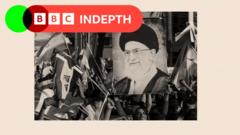In an extraordinary turn of events, the relationship between the United States and Iran has reached a critical juncture following direct military strikes by the U.S. on Tehran’s nuclear installations. This marked departure from decades of tentative avoidance of conflict raises concerns globally about potential escalation into a larger military confrontation.
The president, known for his commitment to a peaceful presidency, has now unleashed military action deemed the most significant of his term. Such direct involvement has left world leaders alarmed about the ramifications for regional stability and the balance of power in the Middle East. Iran’s Supreme Leader Ayatollah Ali Khamenei, now reportedly in a fortified location, faces a monumental dilemma. His response holds the key not only to his regime’s survival but also to the historical narrative he will leave behind.
Experts note the precarious nature of Iran’s position. With mounting Israeli strikes leading to severe decimation of military infrastructure and personnel, the pressure is mounting for Tehran to respond. Hamidreza Aziz from the Middle East Council on Global Affairs remarked, “This is not a war Iran wants,” yet the need to maintain an image of strength complicates the calculations.
A direct hit on U.S. resources, whether military bases in the region or American troops, could trigger a fierce retaliatory response, making diplomacy increasingly fragile. Closing vital shipping routes like the Strait of Hormuz—a key global oil passage—could further isolate Iran, drawing in not only regional partners but also larger powers concerned with economic stability.
The historical burden of Iran’s corrosive war experience further complicates its military options. The violent legacy of previous regional conflicts looms large as the Islamic Revolutionary Guard Corps speaks of potential consequences for the U.S. that would lead to “lasting regret.” Audiovisual reports indicate the extent of destruction from U.S. strikes on crucial nuclear sites, including a high-profile operational strike that could dramatically affect Iran’s nuclear ambitions.
With high-stakes negotiations stalled by this escalation, Iranian Minister Abbas Araghchi has voiced concerns over U.S. expectations undermining sovereign rights, making any form of dialogue appear futile. As Iran contemplates its steps forward, it is possible that historical grievances and aspirations for nuclear development may be revisited amid a backdrop of escalating tensions and shifting alliances.
Calls for diplomatic actions grow louder as European nations urge for measured dialogue rather than military aggression. Yet, the challenges are immense, as recent analyses suggest that Iran may assert its resilience in the face of these attacks while the U.S. attempts to frame the narrative as a military success.
As time passes and decisions loom, both nations are poised at a critical inflection point. The coming days could define the course of U.S.-Iran relations and have lasting implications for regional security and global diplomatic efforts moving forward.





















